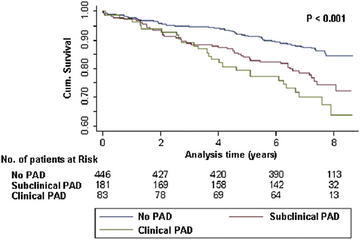Prognostic Usefulness of Clinical and Subclinical Peripheral Arterial Disease in Men With Stable Coronary Heart Disease
Bouisset F, Bongard V, Ruidavets J-B, et al (Toulouse Rangueil Univ Hosp, France; Université de Toulouse III, France) Am J Cardiol 110:197-202, 2012§
J. Black, MD
Evidence Ranking
B
Expert Rating
2
Abstract
The prognostic value of symptomatic peripheral arterial disease (PAD) in patients with coronary heart disease (CHD) is well documented, but few reports differentiating between symptomatic and asymptomatic forms of PAD are available. We investigated the respective prognostic effect of clinical and subclinical PAD on long-term all-cause mortality in patients with stable CHD. We analyzed 710 patients with stable CHD referred for hospitalization for CHD evaluation and management. As a part of the study, they completed questionnaires on medical history, underwent a standardized clinical examination, including ankle-brachial index (ABI) measurement, and provided a fasting blood sample. Three groups of patients were individualized: no PAD (no history of PAD and ABI > 0.9 but ≤1.4); subclinical PAD (no history of PAD but abnormal ABI [i.e., ≤0.9 or >1.4); and clinical PAD (history of claudication, peripheral arterial surgery, or amputation due to PAD). Clinical and subclinical PAD was present in 83 (11.7%) and 181 (25.5%) patients, respectively. After a median follow-up of 7.2 years, 130 patients died. On multivariate analysis adjusted for age, hypertension, diabetes, dyslipidemia, smoking, left ventricular ejection fraction, CHD duration, heart rate, history of stroke or transient ischemic attack, and coronary revascularization, previous clinical PAD (hazard ratio 2.11, 95% confidence interval 1.28 to 3.47) and subclinical PAD (hazard ratio 1.65, 95% confidence interval 1.11 to 2.44) were significantly associated with increased all-cause mortality. In conclusion, our study has demonstrated that the detection of subclinical PAD by ABI in patients with stable CHD provides additional information for long-term mortality risk evaluation (Fig).
Stay updated, free articles. Join our Telegram channel

Full access? Get Clinical Tree



